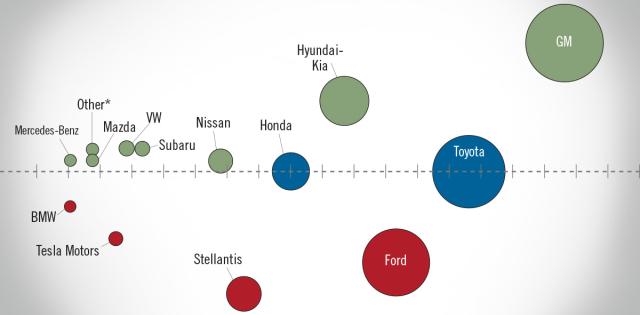The article below is sourced from Bloomberg Wire Service. The views and opinions expressed in this story are those of the Bloomberg Wire Service and do not necessarily reflect the official policy or position of NADA.
The average weight of a new vehicle sold in the US last year was a whopping 4,329 pounds.
That’s over 1,000 pounds higher than the average in 1980, and up about 175 pounds in just the last three years. Essentially, more than a third of the average American car has been added in the past 40 years, a trend now exacerbated by the switch to electric models.
“[Cars] that used to weigh a ton and a half are now three tons,” Ned Curic, chief technology officer of automaker Stellantis NV, said in a recent interview with Automotive News Europe. “It’s not good for the environment, it’s not good for resources, it’s not good for efficiency.” Curic said that reining in vehicle weight at Stellantis, which makes the Jeep, Dodge and Chrysler brands, among others, is currently his biggest engineering challenge.
This wave of vehicle bloat began in the 1980s, thanks in part to new safety regulations. Airbags, crash-test ratings and more robust structures packed on vehicular pounds, while better construction and stronger materials reduced engineers’ need to worry about weight. Efficiency became less of a priority.
Consumer preferences changed, too. In 2018, demand for large SUVs and pickups overtook sedans and hatchbacks in the US. While some trucks got lighter in the past decade, the overall fleet average kept climbing as more suburban families traded their Toyota Corollas and Honda Accords for Ford F-150s and Chevy Silverados.
Then came a push for better fuel economy and emissions reductions, a process that packed on more pounds and culminated in some of the heaviest vehicles yet: battery-powered ones. EV batteries add roughly 1,000 to 1,500 pounds for a long-range sedan or SUV. Those figures could double with the beefiest new pickup trucks coming to the US in the next 12 months, including the 8,000-pound Chevy Silverado and the steel-plated Tesla Cybertruck, weight unknown.
Curic has reason to be worried. Stellantis makes one of the great hulks — the 6,000-pound Ram — and is starting its transition to EVs as America’s heaviest automaker. Its vehicles also have the highest CO2 emissions and the lowest fuel economy as a whole, according to the Environmental Protection Agency’s preliminary 2022 data, the most recent available. America’s other top pickup truck makers, Ford and GM, do little better on fleet-wide metrics.
Trading out polluting cars and trucks for cleaner EVs has significant long-term advantages, particularly for the planet. But roadways full of four-ton hunks of metal moving at sports-car speeds are also less safe. Adding 1,000 extra pounds to a vehicle increases the chance of fatalities in an accident by 47%, according to a study by the National Bureau of Economic Research, a problem some European countries are addressing by taxing vehicles based on weight.
In the US, despite impressive technical leaps in automotive safety, crash fatality rates have risen to a 20-year high and are far worse than similar higher-income countries. Vehicle weight is a key factor.
As the US transition to EVs kicks into high gear, automakers have more reason than ever to focus on slimming down their slates. Heavier vehicles require bigger and more expensive batteries, making high weight and low efficiency a costly combination. Carmakers that can’t keep weight under control won’t be able to compete on price or range.
Shaving pounds from a vehicle can be done by switching to lighter materials and improving battery pack energy density, but those solutions can be costly and slow. Engineers can also reduce weight through more efficient design decisions — and that starts with executives making mass reductions an explicit priority.
Whoever turns things around the quickest has the best chance to compete with Tesla, which dominates the US EV market. Tesla has an all-electric fleet that’s similar in weight to the US average, despite the batteries. Perhaps its biggest trick in getting there was to convince customers that sometimes it’s OK to size down.
For more stories like this, bookmark www.NADAheadlines.org as a favorite in the browser of your choice and subscribe to our newsletter here:











